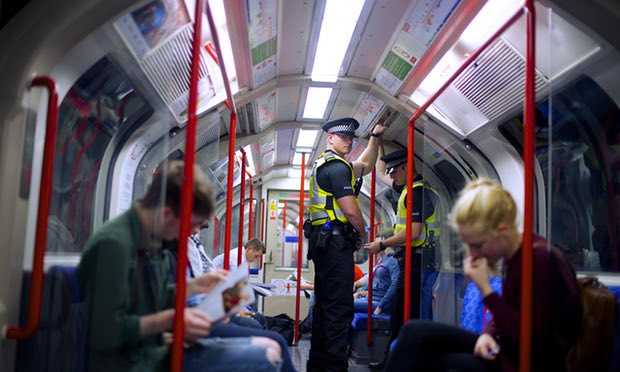Letting people text transport police has pushed up figures for some crimes. The real answer is to make technology part of a wider safety approach
It’s a problem those who travel by train are likely to have faced: what to do when a peaceful carriage is invaded by rowdy drunks? Last year, on a London Euston-bound train, one passenger responded to just that situation by discreetly sending a text message to the British Transport Police (BTP). Twenty minutes later, on arrival at Euston, officers boarded the train and arrested the five men responsible.
Bad behaviour, whether it involves drunkenness, sexual harassment, brawling or verbal abuse, is unfortunately a feature of travelling on public transport. BTP figures for 2015-16 show 48,718 crimes were committed on trains and at stations in England and Wales, although these figures have reduced by 39% since 2005-6.
BTP’s 61016 text message service has made it easier for passengers to report incidents: since it was introduced four years ago, it has received 65,000 texts, responded to 10,000 incidents and recorded 5,000 crimes.
CCTV is now a familiar presence, and evidence suggests it helps to reduce crime, but authorities are increasingly looking at alternative technological approaches. In Germany, the government has said it wants to use facial recognition software at airports and railway stations to improve identification of terrorist suspects.
Meanwhile, a video campaign in New Zealand, aiming to reduce deaths on railway crossings by making pedestrians more conscious of their surroundings, has received 260,000 views on social media, though it’s too soon to assess the long-term impact. Taking a decidedly offbeat approach, the Mexico City authorities installed a “penis seat” on the local metro to highlight the harassment experienced by female passengers.
So how useful is technology in addressing crime and safety issues? Holly Kearl, founder of Stop Street Harassment, argues that technological solutions have to be used in conjunction with other approaches, such as training transport staff to respond to harassment more effectively, and encouraging reporting.
“If a transit authority system offers people a range of reporting options, from in-person reporting to phone calls to texting, hopefully it’s more likely that people will report because there will be an option that feels comfortable,” she says.
The BTP agrees. It still likes passengers to report offences by phone, because they can provide more detail, enabling the police to gauge risk more effectively. It also takes reports via email, and encourages passengers to attach images or video footage of antisocial behaviour. “Rather than people just put[ing] it up on YouTube, we’d much rather they contact us so we can actually do something about it,” says assistant chief constable Paul Brogden.
Technological solutions don’t always come from the top down. Kearl cites HarassMap in Egypt and Safecity in India, initiatives enabling women to share their stories of harassment and abuse in public spaces, as highly effective approaches. The data is aggregated on a map to indicate local trends and raise awareness. Safecity also sends dashboards to police and partner NGOs so that they can take action.
A safety audit of stations in Mumbai confirms that public transport is a particularly unsafe environment for women, says Safecity founder, ElsaMarie D’Silva. “Railways are extremely crowded and therefore hotspots for groping and touching,” she says.
The advantage of offering new ways to record antisocial behaviour is that reporting tends to go up, particularly for hidden sexual offences. The overall crime rate has fallen significantly on the transport networks, but after BTP introduced its Report it to stop it campaign in 2015, the number of reported sexual offences on the rail network rose by 39.5% in England, Scotland and Wales. Similarly, since Safecity’s launch in December 2012, it has received 10,000 reports from more than 50 cities in India, as well as in Nepal, Cameroon and Kenya.
D’Silva says that documenting experiences of harassment and crime is critically important: “If you don’t document it, it will never be captured, thus making the problem invisible. Putting the information in the public domain forces accountability among service providers like the police.”
Technological solutions don’t need to be hugely sophisticated to have an impact, but they do need to be part of a bigger package, D’Silva argues: “Better lighting, clear and visible information on helplines, more visible security personnel, swift official action and active bystander intervention can help in alleviating sexual violence.”
This article first appeared in the Guardian’s public leaders network.

